- Support Forum
- Knowledge Base
- Customer Service
- Internal Article Nominations
- FortiGate
- FortiClient
- FortiADC
- FortiAIOps
- FortiAnalyzer
- FortiAP
- FortiAuthenticator
- FortiBridge
- FortiCache
- FortiCare Services
- FortiCarrier
- FortiCASB
- FortiConverter
- FortiCNP
- FortiDAST
- FortiData
- FortiDDoS
- FortiDB
- FortiDNS
- FortiDLP
- FortiDeceptor
- FortiDevice
- FortiDevSec
- FortiDirector
- FortiEdgeCloud
- FortiEDR
- FortiEndpoint
- FortiExtender
- FortiGate Cloud
- FortiGuard
- FortiGuest
- FortiHypervisor
- FortiInsight
- FortiIsolator
- FortiMail
- FortiManager
- FortiMonitor
- FortiNAC
- FortiNAC-F
- FortiNDR (on-premise)
- FortiNDRCloud
- FortiPAM
- FortiPhish
- FortiPortal
- FortiPresence
- FortiProxy
- FortiRecon
- FortiRecorder
- FortiSRA
- FortiSandbox
- FortiSASE
- FortiSASE Sovereign
- FortiScan
- FortiSIEM
- FortiSOAR
- FortiSwitch
- FortiTester
- FortiToken
- FortiVoice
- FortiWAN
- FortiWeb
- FortiAppSec Cloud
- Lacework
- Wireless Controller
- RMA Information and Announcements
- FortiCloud Products
- ZTNA
- 4D Documents
- Customer Service
- Community Groups
- Blogs
- Fortinet Community
- Knowledge Base
- FortiGate
- Technical Tip: How to configure VPN Site to Site b...
- Subscribe to RSS Feed
- Mark as New
- Mark as Read
- Bookmark
- Subscribe
- Printer Friendly Page
- Report Inappropriate Content
Description
Scope
FortiGate v6.2 or higher.
Solution
The following are the IP address information for both FortiGates.
| Device |
FortiGate - I |
FortiGate - II |
| Wan IP | 172.25.176.62 | 172.25.177.46 |
| LAN IP | 192.168.65.0/24 | 192.168.13.0/24 |
To create an IPsec VPN tunnel on the FortiGate device, select VPN -> IPSec Wizard and input the tunnel name.
Select the Template Type as Site to Site, the 'Remote Device Type' as FortiGate, and select NAT Configuration as No NAT between sites.
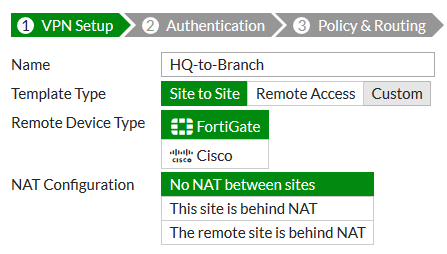
In the Authentication step, set IP Address to the WAN IP address of the remote FortiGate (in the example, 172.25.177.46).
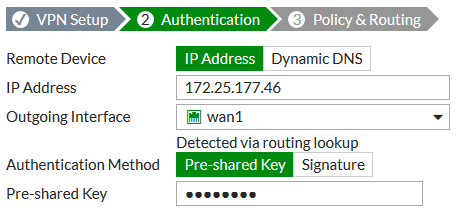
Set Internet Access to None.

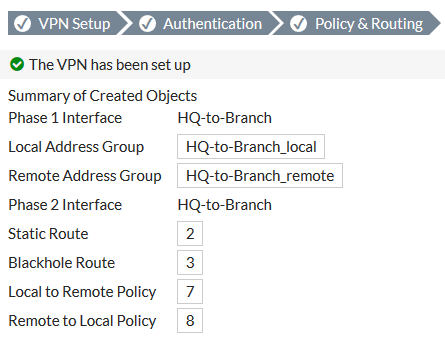




To create a new IPsec VPN tunnel, connect to FGT-II, go to VPN > IPsec Wizard, and create a new tunnel.
In the VPN Setup step, set Template Type to Site to Site, set Remote Device Type to FortiGate, and set NAT Configuration to No NAT between sites.
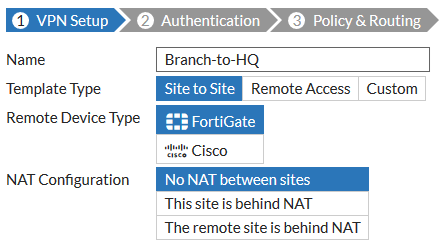
After the IP address is entered, the wizard automatically assigns an interface as the Outgoing Interface.
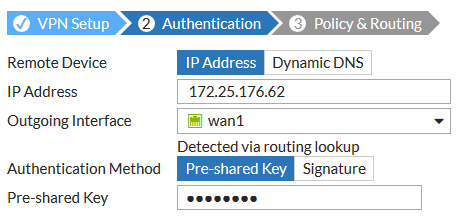

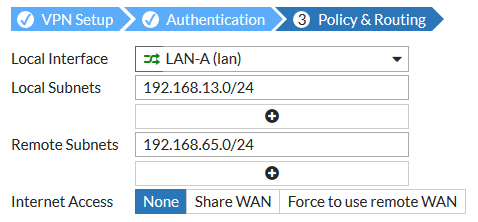





Select the appropriate option in this section for 'Authentication Method', 'IKE' version, 'Transport', 'NAT Traversal', etc.
The 'Transport' option is new at v7.6.x and it is available for IKE version 2.
Move to the next section to configure the Remote Gateway and Remote Subnet.
Select 'next' and move to the next section.
In this section, the 'Outgoing interface', 'Local interface', and 'Local subnets that can access VPN' is configured. Select 'Next'.
After Review the configuration template can be submitted.
The Configuration is complete and once the remote side configuration is done correctly the tunnel is expected to come up and actively pass encrypted traffic.
Verification:
To verify if the LAN subnets can reach each other over the VPN tunnel, initiate an ICMP echo from either side.

Troubleshooting:
If the tunnel UP is not visible, raise a support ticket. It will be helpful to collect the following debug output:
Debug commands:
diagnose debug disable
diagnose debug reset
diagnose vpn tunnel list
diagnose vpn ike log filter clear
diagnose vpn ike log-filter dst-addr4 x.x.x.x <----- Where x.x.x.x is the WAN IP of the remote site.
diagnose debug application ike -1
diagnose debug console timestamp enable
diagnose debug enable
Debugs for v7.4.x and v7.6.x firmware version:
diagnose debug disable
diagnose debug reset
diagnose vpn ike log filter clear
diagnose vpn ike log filter rem-addr4 x.x.x.x {x.x.x.x} <----- Where x.x.x.x is the WAN IP of the remote site.
diagnose debug application ike -1
diagnose debug console timestamp enable
diagnose debug enable
To Stop the debugs logs:
diagnose debug disable
diagnose debug reset
Open another CLI and run the packet capture commands below.
Packet capture:
diagnose sniffer packet any "host <x.x.x.x> and (port 500 or port 4500)" 4 0 a <----- Where x.x.x.x is the WAN IP of the remote site.
Once the commands are executed, try to bring the tunnel UP from the GUI (VPN -> IPsec Monitor -> Bring UP or with the command):
diagnose vpn tunnel up “vpn_tunnel_name <----- Where 'vpn_tunnel_name' is the phase1 name of the respective VPN tunnel.
Once the debugs are collected, stop the debug with the command:
diagnose debug disable
diagnose debug reset
Attach the complete output to the ticket along with the config files of both the FortiGates.
Related documents:
Technical Note: Use of Black hole route in site to site IPsec VPN scenarios
Troubleshooting Tip: Troubleshooting IPsec Site-to-Site Tunnel Connectivity
Troubleshooting Tip: IPsec VPNs tunnels
Technical Tip: Setting multiple DNS server for IPSec dial-up VPN
Technical Tip: NAT-traversal comparison between site-to-site and dial-up” dynamic” tunnels
Technical Tip: FortiGate Hub with multiple IPSec Dial-up phase1 using IKEv2 and PSK authentication
Technical Tip : How to configure multiple VPN tunnels from the same ISP to the same remote peer ISP.
Technical Tip: IPSec dial-up full tunnel with FortiClient
Technical Tip: Differences between Aggressive and Main mode in IPSec VPN configurations
Technical Note: Dynamic routing (BGP) over IPsec tunnel
Technical Tip: OSPF with IPSec VPN for network redundancy
Technical Tip: Dynamic dial-up VPN with OSPF
Technical Tip: Fortinet Auto Discovery VPN (ADVPN)
Technical Tip: 'set net-device' new route-based IPsec logic
Technical Tip: Simple OCVPN deployment
Technical Tip: SD-WAN integration with OCVPN
Technical Tip: Configure IPsec VPN with SD-WAN
Technical Tip: SD-WAN with DDNS type IPsec
Technical Tip: SD-WAN primary and backup ipsec tunnel Scenario
Troubleshooting Tip: IPsec VPN Phase 1 Process - Aggressive Mode
Technical Tip: How to configure IPsec VPN Tunnel using IKE v2
Technical Tip: Hard timeout for Dialup IPSEC VPN Tunnel
Note:
V5.0 up to V6.4 are out of engineering support. These commands might be different on higher versions.
Consider upgrading the firmware level on the device to a supported version (v7.0 up to v7.6). The firmware path and compatibility, depending on the hardware, can be checked here: Upgrade tool
The Fortinet Security Fabric brings together the concepts of convergence and consolidation to provide comprehensive cybersecurity protection for all users, devices, and applications and across all network edges.
Copyright 2025 Fortinet, Inc. All Rights Reserved.



